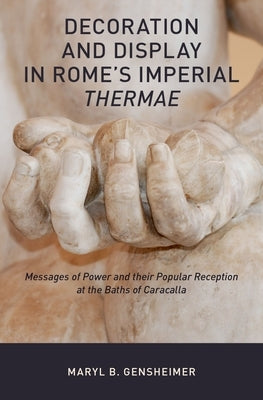1
/
of
1
Oxford University Press, USA
Decoration and Display in Rome's Imperial Thermae: Messages of Power and Their Popular Reception at the Baths of Caracalla
Decoration and Display in Rome's Imperial Thermae: Messages of Power and Their Popular Reception at the Baths of Caracalla
Regular price
$120.00 USD
Regular price
Sale price
$120.00 USD
Shipping calculated at checkout.
Quantity
Couldn't load pickup availability
Across the Roman Empire, ubiquitous archaeological, art historical, and literary evidence attests to the significance of bathing for Romans' routines and relationships. Public baths were popularly viewed as necessities of daily life and important social venues. Given the importance of
bathing to the Roman style of living, by endowing eight magnificent baths (the so-called imperial thermae) in the city of Rome between 25 BCE - 315 CE, imperial patrons greatly enhanced their popular and political stature. Decoration and Display in Rome's Imperial Thermae presents a detailed analysis of the extensive decoration of the best preserved of these bathing complexes, the Baths of Caracalla (inaugurated 216 CE). Maryl B. Gensheimer takes an interdisciplinary approach to existing archaeological data, textual
and visual sources, and anthropological theories in order to generate a new understanding of the visual experience of the Baths of Caracalla and show how the decoration played a critical role in advancing imperial agendas. This reassessment of one of the most ambitious and sophisticated examples of large-scale architectural patronage in Classical antiquity examines the specific mechanisms through which an imperial patron could use architectural decoration to emphasize his own unique sociopolitical position relative to
the thousands of people who enjoyed his benefaction. The case studies addressed herein--ranging from architectural to freestanding sculpture and mosaic--demonstrate that sponsoring monumental baths was hardly an act of altruism. Rather, even while they provided recreation for elite and sub-altern
Romans alike, such buildings were concerned primarily with dynastic legitimacy and imperial largess. Decorative programs articulated these themes by consistently drawing analogies between the subjects of the decoration and the emperor who had paid for it. The unified decorative program--and the
messages of imperial power therein--adroitly honored the emperor and consolidated his reputation.
Author: Maryl B. Gensheimer
Publisher: Oxford University Press, USA
Published: 09/04/2018
Pages: 448
Binding Type: Hardcover
Weight: 1.72lbs
Size: 9.30h x 6.30w x 1.30d
ISBN: 9780190614782
Review Citation(s):
Choice 05/01/2019
bathing to the Roman style of living, by endowing eight magnificent baths (the so-called imperial thermae) in the city of Rome between 25 BCE - 315 CE, imperial patrons greatly enhanced their popular and political stature. Decoration and Display in Rome's Imperial Thermae presents a detailed analysis of the extensive decoration of the best preserved of these bathing complexes, the Baths of Caracalla (inaugurated 216 CE). Maryl B. Gensheimer takes an interdisciplinary approach to existing archaeological data, textual
and visual sources, and anthropological theories in order to generate a new understanding of the visual experience of the Baths of Caracalla and show how the decoration played a critical role in advancing imperial agendas. This reassessment of one of the most ambitious and sophisticated examples of large-scale architectural patronage in Classical antiquity examines the specific mechanisms through which an imperial patron could use architectural decoration to emphasize his own unique sociopolitical position relative to
the thousands of people who enjoyed his benefaction. The case studies addressed herein--ranging from architectural to freestanding sculpture and mosaic--demonstrate that sponsoring monumental baths was hardly an act of altruism. Rather, even while they provided recreation for elite and sub-altern
Romans alike, such buildings were concerned primarily with dynastic legitimacy and imperial largess. Decorative programs articulated these themes by consistently drawing analogies between the subjects of the decoration and the emperor who had paid for it. The unified decorative program--and the
messages of imperial power therein--adroitly honored the emperor and consolidated his reputation.
Author: Maryl B. Gensheimer
Publisher: Oxford University Press, USA
Published: 09/04/2018
Pages: 448
Binding Type: Hardcover
Weight: 1.72lbs
Size: 9.30h x 6.30w x 1.30d
ISBN: 9780190614782
Review Citation(s):
Choice 05/01/2019
About the Author
Maryl B. Gensheimer is Assistant Professor of Roman Art and Archaeology at the University of Maryland.
Share


